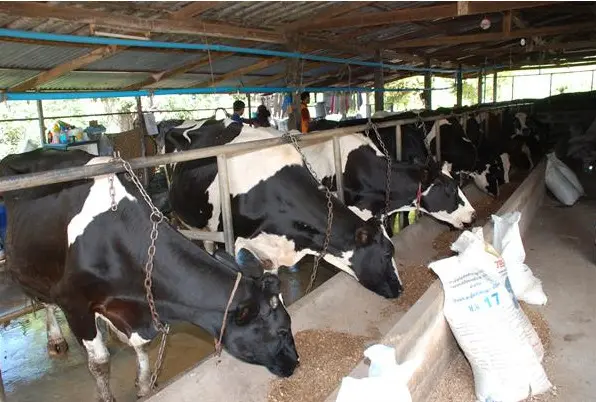News
Milking Break and Production Costs Creating a Cows Milk Shortage in Thailand
According to the Deputy Director-General of the Department of Livestock Development, the quantity of raw cows milk in Thailand has currently reduced by 400 tonnes per day from the previous year’s average as farmers enter milking break and reduce livestock rearing.
The milking break period before cows give birth after the regular raising cycle is connected to the drop. Furthermore, due to the high cost of animal feed ingredients, several farmers have suspended rearing.
The department is accelerating efforts to expand and promote the use of animal feed, which helps lower production costs, with the expectation that raw milk volume will progressively increase to meet demand, in accordance with the milk production cycle.
According to Prapas Phinyocheep, Deputy Director-General of the Department of Livestock Development, the present volume of raw cows milk in the country is lower than the national average. The average daily raw milk production in 2022 was roughly 3,500 tonnes. In 2023, the average daily raw milk production in May was around 2,900 tonnes, a reduction of 400 tonnes per day or 12% from the previous year’s average of 3,300 tonnes per day.
From June to September, most cows are nearing calving, leading farmers to take a milking vacation. Furthermore, as a result of the COVID-19 epidemic and high livestock feed prices, some farmers have stopped rearing or reduced the number of cows, resulting in higher milk production costs.
To address the issue, the department has launched programmes to assist small-scale dairy farmers in lowering the cost of animal feed, which accounts for 60-70% of overall production costs, by encouraging farmers to cultivate roughage such as grass for feed rather than purchasing processed feed.
Providing grass seeds to farmers
The department has established a national goal of 50,000 rai (20,000 acres) for grass growth and is currently providing grass seeds to farmers. Currently, 27,000 rai (10,800 acres) are under cultivation, although it was struck by drought at the start of this year. Efforts are now undertaken to meet the project’s goal.
Another endeavour is to promote Dry TMR (Total Mixed Ration) feed, which is a complete mixed feed made by blending roughage and concentrated feed in the appropriate amounts.
The department tested it in ten provinces across all areas and discovered that it decreases production costs by 3 baht per kilogram of cows milk, or about 10%, and plans to expand the programme to reach more farmers.
Milk is an important part of children’s meals because it helps them grow. According to experts, it contains calcium, which is good for the teeth and bones, as well as other health benefits such as boosting the immune system, enhancing heart health, and improving the skin.
Despite these benefits, a study found that cows milk consumption among young Thais is low, raising concerns about their small stature.
Thai children are typically short because they consume insufficient milk, according to Dr. Suwannachai Wattanayingcharoenchai, director general of the Department of Health (DoH).
Over the last few years, the proportion of “short” Thai youths has risen from 9.5% to 10.4%. And that small stature is due to a lack of milk consumption.
Benefits of children drinking milk
Dr Suwannachai was speaking during a special event commemorating World Milk Day 2023, which he hosted and chaired at the DoH’s office. The goal was to raise awareness about the benefits of drinking milk.
The Food and Agriculture Organisation (FAO) of the United Nations established World Milk Day on June 1 to emphasise the importance of milk as part of a balanced diet.
He claims that the average height of a 12-year-old male is 148.4 centimetres and 149.3 centimetres for girls. A 19-year-old boy’s average height is 166.8 cm, while a girl’s average height is 157.8 cm.
The Thai government has pushed the consumption of cows milk as a means of increasing the average height of young Thais. It has set a target of increasing the average height of Thai adolescent boys over the age of 18 to 170 cm and teenage girls to 165 cm by 2027.
According to a recent study conducted by the DoH, Unicef Thailand, and Suan Dusit Rajabhat University including children aged 6 to 19, the majority of Thai youngsters consume an average of one glass of milk every day.
Milk consumption among Thais is relatively modest, at roughly 21.5 litres per person per year, compared to 32.8 litres for Japanese and 60 litres for Indians.
By 2027, the Thai government hopes to raise the average milk intake of Thais to 25 litres per person per year.
Dr. Suwannachai emphasised that people should drink two glasses of fresh cows milk every day and eat a range of foods from all five food categories in the appropriate serving sizes over the course of three meals.
“In addition, teenagers should exercise for at least 60 minutes per day and participate in outdoor activities to increase vitamin D levels, which aid in the absorption of calcium from milk.” A decent night’s sleep is also essential. “All of these things should help them grow and develop properly in accordance with their age, including their height,” he stated.
Cows Milk is beneficial to everyone.
Milk, according to Assoc Prof Prapaisri Sirichakwal, advisor to Mahidol University’s Institute of Nutrition, is not only high in protein but also high in vitamins and minerals such as vitamin B2 and calcium.
“Milk is good for you at any age.” It is one of the most calcium-rich foods available. And milk proteins are considered to be of high quality,” she added, adding that drinking milk helps children grow and is also beneficial to elders since it helps preserve bone strength and prevents osteoporosis.
According to her, one serving or glass of (cow’s) milk (approximately 250 mL) can provide persons with 17-22% of their daily required intake. It contains approximately 7-8 grammes of protein.
Milk is also a good source of vitamin B2, which helps the neurological system and energy metabolism function normally. According to Prapaisri, a serving of milk offers roughly 25-30% of the daily value.
According to her, a glass of whole milk contains roughly 8-9 grammes of fat (about 12% of the daily value).
“If you are concerned about the fat content of full-fat milk, choose skimmed milk instead,” Prapaisri said.
Cow’s milk, on the other hand, is not for everyone. According to Prapaisri, certain people are intolerant to lactose, a sugar contained in milk.
People who are lactose intolerant are unable to adequately digest the sugar because their systems do not create enough lactase, the enzyme required to break down lactose. As a result, the undigested lactose remains in the gut and is later broken down by bacteria, resulting in digestive issues such as abdominal pain, flatulence, bloating, and diarrhoea.
Lactose intolerance symptoms might be unpleasant, but they are controllable by adjusting your diet, she says.
“If you’re lactose intolerant, you don’t have to give up cow’s milk completely because it’s a good source of nutrients, including calcium.” Try not to drink too much milk all at once, but rather a bit at a time. “Many lactose intolerant people can tolerate a small amount of milk,” Prapaisri remarked.
She also mentioned mixing cow’s milk with other foods.
“For example, during an afternoon break, you could have a Chinese bun or a sandwich with milk.” “You may notice fewer symptoms if you take it with food,” she said.
She did, however, mention that certain newborns and children are allergic to the protein in cow’s milk. They may develop symptoms such as lip swelling, rashes, vomiting, diarrhoea, asthma, and difficulty breathing.
She emphasised that lactose intolerance is not the same as milk allergy. The first is a digestive issue, whereas the second is an immune system disorder.
She claims that the two illnesses can make it difficult to digest cow’s milk.
Prapaisri advised those who choose plant-based milk alternatives to replace cow’s milk to carefully consider the variations in nutritional content when comparing them to dairy milk.
“Plant-based milk products may be deficient in calcium and other nutrients found in cow’s milk.” “You have to look at the labels to see if they are fortified,” she added, adding that many plant-based milk alternatives lack the same nutrients as cow’s milk.
She also advised against eating diets high in sugar, fat, and salt because they raise the chance of health problems. Excessive salt consumption might result in calcium loss.
“Consuming too much salty foods can deplete calcium in the body,” Prapraisri explained, adding that when sodium intake is too high, the body flushes it out through the urine, taking calcium with it.



































